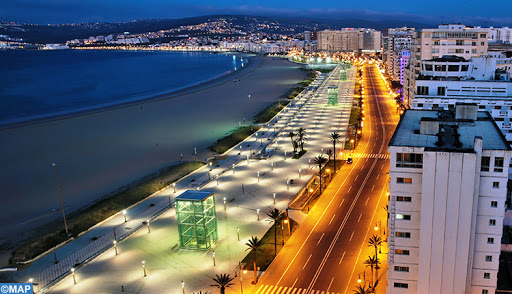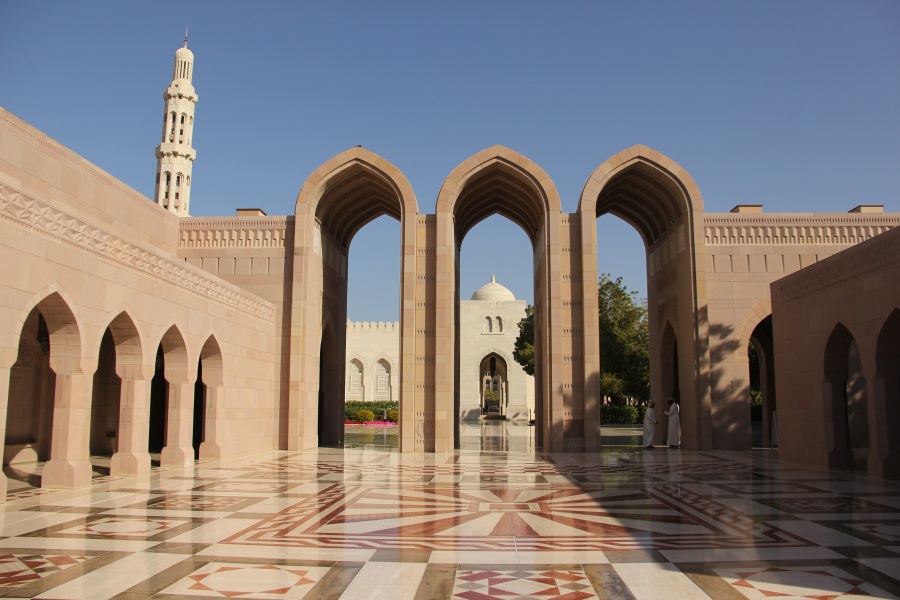
Jordan
Petra is an important archaeological site in Jordan and the capital of the ancient Nabataean kingdom, whose inhabitants called it Raqmu. Petra's name, which means stone, and her name fits perfectly; it is not a city built with stone, but literally excavated and carved in stone. The settlement of Petra is located in a narrow valley, to the east of the Arava Valley, which stretches from the Dead Sea to the Gulf of Aqaba. The most famous remains of Petra are undoubtedly its buildings carved into the same rock as the valley (hemispeos), in particular, the buildings known as the Khazneh (the Treasury) and the Deir (the Monastery). Founded in antiquity at the end of the 8th century BC. C. by the Edomites, it was occupied in the 6th century B.C. C. by the Nabateans who made it prosper thanks to its location on the caravan route that transported incense, spices and other luxury products between Egypt, Syria, Arabia and the southern Mediterranean. Circa 6th century AD C., the change of the commercial routes and the earthquakes suffered, led to the abandonment of the city by its inhabitants. It lay by the wayside until the site was rediscovered to the Western world in 1812 by the Swiss explorer Jean Louis Burckhardt (1784-1817). Numerous buildings whose facades are carved directly into the rock, form a unique monumental complex, which since December 6, 1985 is inscribed on the UNESCO World Heritage List. The area surrounding the site is also, since 1993, a National Archaeological Park. Since July 7, 2007, Petra is part of the new seven wonders of the modern world.... THE ROUTES ARE STILL IN PREPARATION!!
Petra is an important archaeological site in Jordan and the capital of the ancient Nabataean kingdom, whose inhabitants called it Raqmu. Petra's name, which means stone, and her name fits perfectly; it is not a city built with stone, but literally excavated and carved in stone. The settlement of Petra is located in a narrow valley, to the east of the Arava Valley, which stretches from the Dead Sea to the Gulf of Aqaba. The most famous remains of Petra are undoubtedly its buildings carved into the same rock as the valley (hemispeos), in particular, the buildings known as the Khazneh (the Treasury) and the Deir (the Monastery). Founded in antiquity at the end of the 8th century BC. C. by the Edomites, it was occupied in the 6th century B.C. C. by the Nabateans who made it prosper thanks to its location on the caravan route that transported incense, spices and other luxury products between Egypt, Syria, Arabia and the southern Mediterranean. Circa 6th century AD C., the change of the commercial routes and the earthquakes suffered, led to the abandonment of the city by its inhabitants. It lay by the wayside until the site was rediscovered to the Western world in 1812 by the Swiss explorer Jean Louis Burckhardt (1784-1817). Numerous buildings whose facades are carved directly into the rock, form a unique monumental complex, which since December 6, 1985 is inscribed on the UNESCO World Heritage List. The area surrounding the site is also, since 1993, a National Archaeological Park. Since July 7, 2007, Petra is part of the new seven wonders of the modern world.... THE ROUTES ARE STILL IN PREPARATION!!
Show Offers

Kingdom of Morocco
Morocco (in Arabic: al-Maghrib, 'the country of the West'; officially called the Kingdom of Morocco) is a sovereign country located in the Maghreb, North Africa, with coastlines on the océ Atlantic and the Mediterranean Sea. Morocco became independent on March 25 from France. It is separated from mainland Europe by the Strait of Gibraltar. It limits to the east with Algeria -the border has been closed since 1994-, to the south with the Saharawi Arab Democratic Republic, to the north with Spain, its main commercial partner with which it shares both maritime and land -Ceuta, Melilla and the places of sovereignty. In 1984 the assembly of the Organization for African Unity (OAU), the predecessor body of the AU and of which Morocco was a founding member, accepted the Saharawi Arab Democratic Republic (SADR) as a member. In response, Morocco withdrew from the organization. It is a member of the Arab League, the Arab Maghreb Union, the Francophone International Organization, the Organization of the Islamic Conference, the Union for the Mediterranean, the European Broadcasting Union, the Group of 77 and the North-South Center. It is also an important ally of the United States outside of NATO. From 1984 to 2017, it was the only African country that was not a member of the African Union. The Moroccan State was readmitted by an absolute majority, on January 30, 2017, during the XXVIII Summit of the African Union, which took place in Ethiopia. THE ROUTES ARE STILL IN PREPARATION!!
Morocco (in Arabic: al-Maghrib, 'the country of the West'; officially called the Kingdom of Morocco) is a sovereign country located in the Maghreb, North Africa, with coastlines on the océ Atlantic and the Mediterranean Sea. Morocco became independent on March 25 from France. It is separated from mainland Europe by the Strait of Gibraltar. It limits to the east with Algeria -the border has been closed since 1994-, to the south with the Saharawi Arab Democratic Republic, to the north with Spain, its main commercial partner with which it shares both maritime and land -Ceuta, Melilla and the places of sovereignty. In 1984 the assembly of the Organization for African Unity (OAU), the predecessor body of the AU and of which Morocco was a founding member, accepted the Saharawi Arab Democratic Republic (SADR) as a member. In response, Morocco withdrew from the organization. It is a member of the Arab League, the Arab Maghreb Union, the Francophone International Organization, the Organization of the Islamic Conference, the Union for the Mediterranean, the European Broadcasting Union, the Group of 77 and the North-South Center. It is also an important ally of the United States outside of NATO. From 1984 to 2017, it was the only African country that was not a member of the African Union. The Moroccan State was readmitted by an absolute majority, on January 30, 2017, during the XXVIII Summit of the African Union, which took place in Ethiopia. THE ROUTES ARE STILL IN PREPARATION!!
Show Offers

United Emirates
The United Arab Emirates, known simply as the United Arab Emirates, is a sovereign country constituted as a federal monarchy in the Middle East, located on the Arabian Peninsula. It comprises seven emirates: Abu Dhabi, Ajman, Dubai, Fujairah, Ras al-Khaimah, Sharjah, and Umm al-Qaywayn. It borders Oman to the southeast, the Persian Gulf to the north, and Saudi Arabia to the west and south. Oil is the main source of income and the essential component of its GDP.7 The United Arab Emirates is the 30th economy by volume of GDP and in terms of the human development index prepared by the United Nations, it ranks n. 42 of 188 countries in 2016. The first important settlements in the region date back to the Bronze Age. The 7th century AD saw the arrival of Islam and during the 16th century the territory fell under the influence of European colonial powers, eventually establishing British rule. Following the end of the UK protectorate in December 1971, six sheikhs formed the union by signing the 1971 constitution, which Ras al-Khaimah joined a few months later. Each emirate retains considerable political, judicial, and economic autonomy.... THE ROUTES ARE STILL IN PREPARATION!!
The United Arab Emirates, known simply as the United Arab Emirates, is a sovereign country constituted as a federal monarchy in the Middle East, located on the Arabian Peninsula. It comprises seven emirates: Abu Dhabi, Ajman, Dubai, Fujairah, Ras al-Khaimah, Sharjah, and Umm al-Qaywayn. It borders Oman to the southeast, the Persian Gulf to the north, and Saudi Arabia to the west and south. Oil is the main source of income and the essential component of its GDP.7 The United Arab Emirates is the 30th economy by volume of GDP and in terms of the human development index prepared by the United Nations, it ranks n. 42 of 188 countries in 2016. The first important settlements in the region date back to the Bronze Age. The 7th century AD saw the arrival of Islam and during the 16th century the territory fell under the influence of European colonial powers, eventually establishing British rule. Following the end of the UK protectorate in December 1971, six sheikhs formed the union by signing the 1971 constitution, which Ras al-Khaimah joined a few months later. Each emirate retains considerable political, judicial, and economic autonomy.... THE ROUTES ARE STILL IN PREPARATION!!
Show Offers

Oman
Oman, officially the Sultanate of Oman, is a country located in Western Asia, on the east coast of the Arabian Peninsula. It borders the United Arab Emirates to the northwest, Saudi Arabia to the west, and Yemen to the southwest. The coastline is formed by the Arabian Sea to the south and east, and the Gulf of Oman to the northeast. It also has two enclaves, the Musandam Peninsula, in the north of the United Arab Emirates, and Madha, in the east of the same country. Beginning in the 17th century, Oman had its own empire and disputes with Spain and the Netherlands for control over the Persian Gulf and the Indian Ocean, Oman's influence or control extended across the Strait of Hormuz to Iran and what is now Pakistan. reaching south of Zanzibar. Its power declined during the 20th century and the sultanate came under heavy British influence, although Oman was never formally part of the British Empire or a British protectorate. Oman has strong military and political ties with the United Kingdom and the United States, although it maintains an independent foreign policy. Oman is an absolute monarchy in which the Sultan of Oman exercises absolute authority, but his parliament has some legislative and supervisory powers. In November 2010, the United Nations Development Program named Oman, among 135 countries in the world, as the country that has improved the most in the last 40 years. According to the 2010 international indices, Oman is one of the most developed and stable countries in the Arab world.... THE ROUTES ARE STILL IN PREPARATION
Oman, officially the Sultanate of Oman, is a country located in Western Asia, on the east coast of the Arabian Peninsula. It borders the United Arab Emirates to the northwest, Saudi Arabia to the west, and Yemen to the southwest. The coastline is formed by the Arabian Sea to the south and east, and the Gulf of Oman to the northeast. It also has two enclaves, the Musandam Peninsula, in the north of the United Arab Emirates, and Madha, in the east of the same country. Beginning in the 17th century, Oman had its own empire and disputes with Spain and the Netherlands for control over the Persian Gulf and the Indian Ocean, Oman's influence or control extended across the Strait of Hormuz to Iran and what is now Pakistan. reaching south of Zanzibar. Its power declined during the 20th century and the sultanate came under heavy British influence, although Oman was never formally part of the British Empire or a British protectorate. Oman has strong military and political ties with the United Kingdom and the United States, although it maintains an independent foreign policy. Oman is an absolute monarchy in which the Sultan of Oman exercises absolute authority, but his parliament has some legislative and supervisory powers. In November 2010, the United Nations Development Program named Oman, among 135 countries in the world, as the country that has improved the most in the last 40 years. According to the 2010 international indices, Oman is one of the most developed and stable countries in the Arab world.... THE ROUTES ARE STILL IN PREPARATION
Show Offers
Copyright 2019- MISRONA TOURS- All Rights Reserved. Designed by star-websolution.com

 ESPAÑOL
ESPAÑOL ITALIANO
ITALIANO




